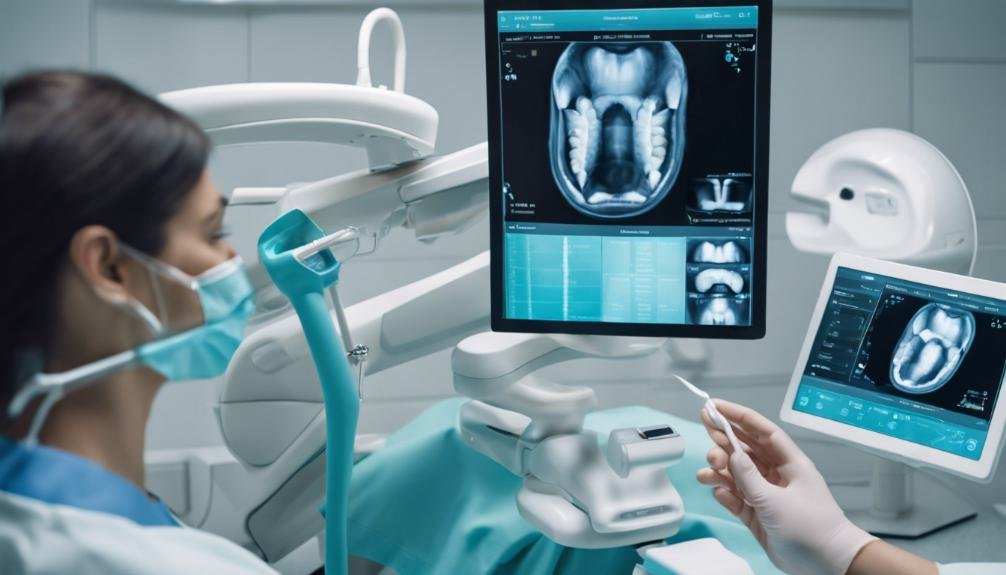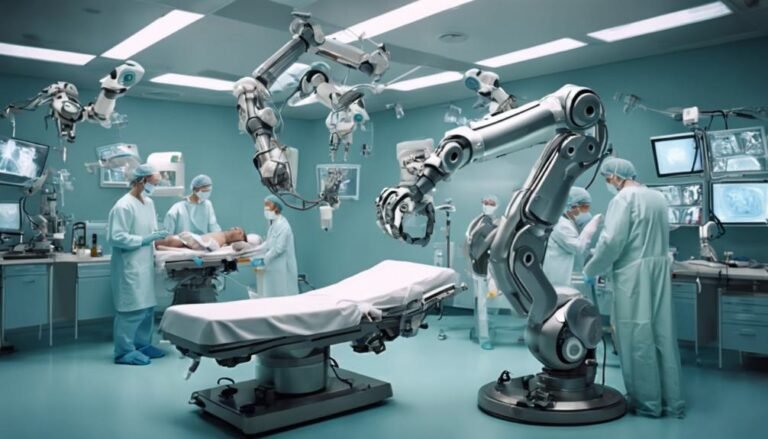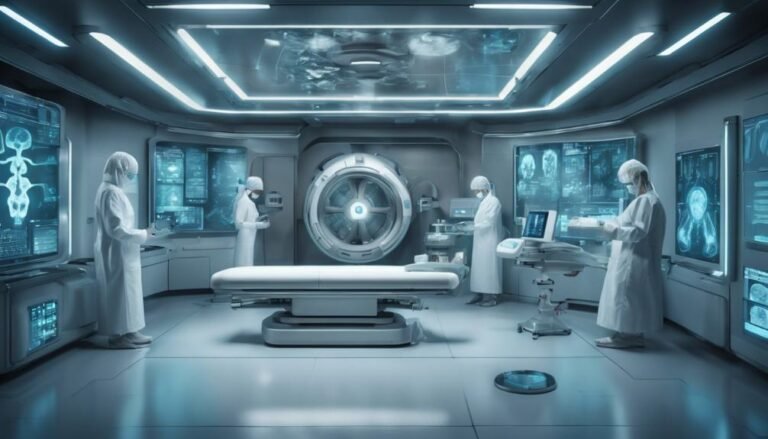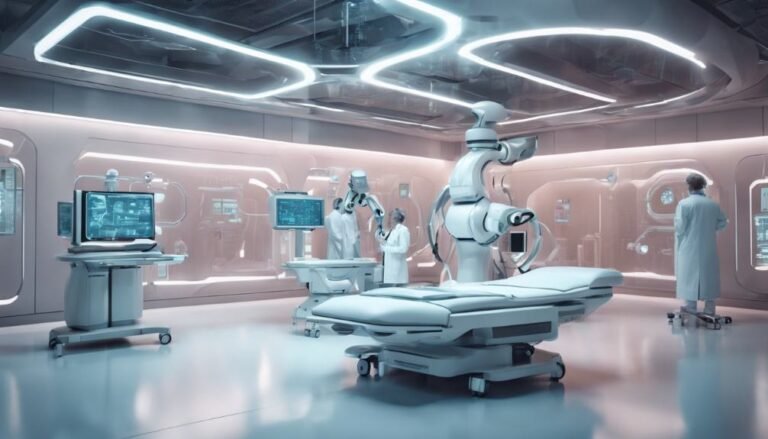AI in Dental Imaging
Imagine a scenario where AI can accurately detect cavities in their earliest stages, potentially preventing extensive dental procedures. This breakthrough in dental imaging is just one of the many ways artificial intelligence is transforming oral healthcare practices. As you consider the implications of AI in dentistry, it prompts discussions around ethics, patient privacy, and the role of human expertise alongside machine intelligence. The intersection of cutting-edge technology and traditional dental care poses intriguing questions that warrant exploration in this ever-evolving field.
Key Takeaways
- AI enhances diagnostic accuracy in dental imaging.
- Automation improves treatment planning and image analysis.
- AI aids in precise cavity detection and abnormality identification.
- Integration with digital workflows enhances diagnostic accuracy.
- Predictive analytics optimize radiographic interpretation and personalized care.
Enhanced Detection of Dental Issues
By utilizing artificial intelligence algorithms, dental imaging technology has greatly enhanced the detection of various dental issues, providing detailed and precise analysis of oral health conditions. AI-driven analysis has revolutionized the field by leveraging machine learning advancements to interpret complex data from dental images with remarkable accuracy. Through the integration of AI algorithms, dental professionals can now detect subtle abnormalities or early signs of oral diseases that may have previously gone unnoticed.
These machine learning advancements enable the automated analysis of dental images, allowing for efficient and standardized evaluations. By training algorithms on vast datasets of dental images, AI can recognize patterns and deviations that might be challenging for the human eye to identify consistently.
This not only enhances the speed of diagnosis but also ensures a more thorough assessment of dental health. The precision and reliability of AI-driven analysis in dental imaging contribute significantly to improving patient outcomes and promoting proactive oral healthcare practices.
Automated Image Analysis
Utilizing advanced artificial intelligence algorithms streamlines the process of analyzing dental images automatically, enhancing diagnostic accuracy and efficiency. AI advancements in dental technology have revolutionized the way oral health is monitored and treated. Automated image analysis offers numerous benefits in dentistry, such as reducing human error, providing consistent evaluations, and expediting the identification of potential issues.
Through AI advancements, dental technology has been able to automate the analysis of various dental imaging modalities like X-rays, CBCT scans, and intraoral photographs. This automation greatly improves the speed at which dental professionals can interpret images, leading to quicker treatment decisions and better patient outcomes. The streamlined process also allows for a more detailed examination of oral health, ensuring that no details are overlooked.
Moreover, automation benefits oral health by enabling early detection of dental problems, allowing for timely interventions and preventive measures. By leveraging AI in automated image analysis, dental practices can enhance their diagnostic capabilities, ultimately leading to improved patient care and treatment outcomes.
Improved Diagnostic Accuracy
Advanced artificial intelligence algorithms enhance diagnostic accuracy in dental imaging by precisely analyzing images and detecting subtle abnormalities. Machine learning, along with advanced algorithms, plays an essential role in improving diagnostic precision and ultimately leads to better outcomes for patients.
These AI systems can efficiently identify minute details that might be overlooked by the human eye, aiding in the early detection of dental issues.
By utilizing vast datasets to train and fine-tune their algorithms, AI systems continuously learn and improve their diagnostic capabilities. This iterative process results in enhanced accuracy and reliability in interpreting dental images.
As a result, dental professionals can make more informed decisions based on the thorough analysis provided by AI technology.
The integration of AI in dental imaging not only streamlines the diagnostic process but also guarantees that potential problems are identified promptly, leading to more effective treatment planning and improved patient care.
Through the synergy of machine learning and advanced algorithms, diagnostic accuracy in dental imaging is significantly improved, paving the way for better outcomes and overall treatment efficacy.
Accelerated Treatment Planning
When utilizing AI in dental imaging for accelerated treatment planning, you can expect improved diagnostic accuracy and streamlined workflow efficiency.
AI algorithms can quickly analyze imaging data to provide detailed treatment plans with precision.
This technology optimizes the process, enabling faster decision-making and improved patient care outcomes.
Enhanced Diagnostic Accuracy
By leveraging artificial intelligence (AI) in dental imaging, practitioners can greatly enhance diagnostic accuracy, thereby expediting treatment planning processes. AI-driven predictions based on image enhancement techniques can provide clinicians with valuable insights into potential dental issues that may not be easily detectable through traditional methods. These AI algorithms analyze and interpret imaging data with a high level of precision, offering diagnostic support that aids in the early detection of dental conditions.
Through the integration of AI technology, practitioners can achieve treatment optimization by receiving more accurate and detailed information about patients' oral health. Enhanced diagnostic accuracy allows for a thorough understanding of the patient's dental needs, leading to personalized treatment plans that are tailored to each individual.
Streamlined Workflow Efficiency
Utilizing artificial intelligence (AI) in dental imaging can greatly streamline workflow efficiency by accelerating the treatment planning process. Workflow optimization through AI applications allows for the seamless integration of advanced algorithms that enhance the efficiency of tasks traditionally performed by dental professionals.
AI applications in dental imaging facilitate efficiency enhancement by automating repetitive processes, such as image analysis and data interpretation. By swiftly analyzing radiographs, AI algorithms can identify patterns, anomalies, and potential issues, reducing the time required for treatment planning considerably.
The integration of AI in dental imaging not only expedites the treatment planning phase but also guarantees a more precise and consistent approach. By utilizing machine learning algorithms, AI can assist in developing personalized treatment plans tailored to each patient's unique needs, ultimately optimizing workflow efficiency in dental practices.
Precision in Cavity Detection
How does AI enhance the precision of cavity detection in dental imaging?
AI technologies like deep learning and machine learning play a pivotal role in improving the accuracy of cavity detection through advanced techniques such as cavity classification and image segmentation.
By utilizing deep learning algorithms, AI systems can analyze dental images with a high level of precision, distinguishing between normal tooth structure and areas of decay.
In cavity classification, AI algorithms are trained to recognize different types of cavities based on their characteristics, aiding in early detection and treatment planning.
Image segmentation further enhances precision by precisely outlining the borders of cavities, allowing for a more detailed assessment of the affected areas.
This level of accuracy is particularly beneficial in identifying small or hidden cavities that may be challenging to detect with the naked eye or traditional imaging methods.
Customized Patient Care
AI technologies in dental imaging enable the customization of patient care through tailored treatment plans and individualized diagnostic approaches. By integrating AI into dental practices, personalized treatment options can be designed to meet the specific needs of each patient, leading to improved patient satisfaction and better overall outcomes.
The technology integration allows for a more precise analysis of patient data, facilitating the creation of treatment plans that consider each patient's unique oral health profile. This personalized approach not only enhances the accuracy of diagnoses but also guarantees that interventions are tailored to the individual, increasing the likelihood of successful treatment outcomes.
Moreover, customized patient care supported by AI in dental imaging promotes patient satisfaction by offering a more personalized experience. Patients feel valued and cared for when their dental health needs are addressed in a way that's tailored to their specific requirements, leading to a higher level of comfort and trust in the treatment process.
Ultimately, the implementation of AI technologies in dental imaging enhances patient outcomes by providing individualized care that prioritizes the well-being of each patient.
Early Detection of Abnormalities
Enhancing diagnostic accuracy, dental imaging powered by artificial intelligence enables the early detection of abnormalities in oral health conditions. Through AI advancements, the ability to identify subtle changes in dental images that may indicate potential issues has greatly improved. Early intervention facilitated by AI in dental imaging plays an essential role in achieving improved outcomes for patients.
By utilizing AI algorithms, dental professionals can detect abnormalities such as cavities, periodontal disease, or even oral cancers at their nascent stages. This early detection not only allows for timely treatment but also enhances the chances of successful intervention. Patients benefit greatly from this proactive approach, as it can lead to better prognoses and reduced treatment complexities.
The integration of AI in dental imaging not only streamlines the diagnostic process but also revolutionizes patient care by focusing on preventive measures. Through early detection and intervention, AI-driven dental imaging contributes to enhanced patient outcomes and overall oral health management.
Integration With Digital Workflows
In addition, by integrating AI with digital workflows, you can optimize your dental imaging processes. This integration enhances the accuracy of diagnostics by leveraging AI algorithms to analyze images effectively.
Moreover, by incorporating AI, you can improve treatment planning through more precise and data-driven insights.
Streamlining Imaging Processes
To streamline imaging processes within dental practices, integrating digital workflows is essential for optimizing efficiency and enhancing diagnostic accuracy.
By incorporating AI optimization and workflow automation into imaging technology, dental practices can greatly improve their operational efficiency. AI algorithms can assist in automating repetitive tasks, such as image analysis and data management, saving valuable time for dental professionals.
Workflow automation tools can streamline the process of capturing, storing, and analyzing dental images, ensuring a seamless flow of information within the practice. These tools also help in organizing patient data efficiently, reducing the risk of errors and improving overall productivity.
Additionally, integrating digital workflows allows for quick access to patient images, facilitating faster diagnoses and treatment planning.
Enhancing Diagnostic Accuracy
By integrating AI technology with digital workflows in dental imaging, enhanced diagnostic accuracy can be achieved through streamlined processes and efficient data management. AI algorithms play an essential role in improving diagnostic efficiency by analyzing images with a high level of precision. These algorithms can quickly detect patterns, anomalies, and potential issues in radiographs, intraoral scans, and CBCT images, aiding in the early detection of dental problems.
Through the integration of AI algorithms into digital workflows, dental professionals can benefit from automated image analysis, reducing the time needed for manual review and interpretation. This not only enhances diagnostic accuracy but also allows for more consistent results across different cases.
Additionally, AI technology can assist in flagging critical findings for further evaluation, ensuring that no significant details are overlooked during the diagnostic process.
Improving Treatment Planning
Integrating AI technology with digital workflows in dental imaging not only enhances diagnostic accuracy but also plays a pivotal role in improving treatment planning efficiency by streamlining processes and facilitating data management. When it comes to treatment optimization and improving patient outcomes, the seamless integration of AI into clinical workflows proves to be highly beneficial.
By leveraging AI algorithms in treatment planning, dental professionals can access valuable insights and predictive analytics to tailor personalized treatment plans for each patient. AI's ability to analyze vast amounts of patient data quickly and accurately allows for the identification of patterns and trends that can greatly impact treatment outcomes.
Moreover, the integration of AI technology with digital workflows enables real-time collaboration among dental teams, enhancing communication and decision-making processes.
This integration streamlines the treatment planning workflow, from initial diagnosis to final treatment implementation, ensuring a more efficient and effective patient care experience. Ultimately, by incorporating AI into treatment planning processes, dental practices can achieve higher levels of precision, leading to improved patient outcomes and satisfaction.
Predictive Analytics for Oral Health
Utilizing advanced algorithms, predictive analytics in oral health enables the proactive identification of potential dental issues based on historical data and patterns. Through oral hygiene monitoring and AI algorithms, predictive models can assess individual risk factors and predict the likelihood of developing certain oral health conditions.
These models analyze various data points, including patient demographics, medical history, and previous dental records to generate personalized insights.
By incorporating preventive care strategies based on these predictive analytics, dental professionals can offer targeted interventions to patients, ultimately leading to improved oral health outcomes. For instance, individuals identified as high-risk for periodontal disease may receive tailored recommendations for more frequent cleanings or specific oral hygiene practices to mitigate risks.
Moreover, predictive analytics can help optimize appointment scheduling by predicting when patients are likely to require follow-up treatments or preventive measures. This proactive approach enhances patient care, streamlines workflow efficiency, and contributes to overall practice success in maintaining oral health.
AI-Powered Radiographic Interpretation
To enhance diagnostic accuracy and efficiency in dental imaging, AI technologies are revolutionizing radiographic interpretation through advanced algorithms and machine learning capabilities. AI-powered radiographic interpretation is greatly improving the field by providing AI-enhanced diagnoses and leveraging radiographic advancements. Machine learning applications play an essential role in this process, allowing for the automation of tasks that traditionally required extensive manual analysis.
Through AI-powered radiographic interpretation, dentists can benefit from more accurate and timely diagnoses. AI algorithms can quickly analyze radiographic images, detecting abnormalities or potential issues that might be overlooked by the human eye. This technology enables clinicians to make more informed treatment decisions and provide better patient care.
Moreover, the integration of AI in dental imaging technology enhances workflow efficiency by reducing the time spent on interpreting radiographs manually. By automating repetitive tasks, AI frees up valuable time for dental professionals to focus on patient care and complex cases.
Conclusion
You've learned about the transformative impact of AI in dental imaging, but did you know that AI algorithms have been shown to improve diagnostic accuracy by up to 90% in detecting oral health issues?
With automated image analysis, precision cavity detection, and predictive analytics, the future of dentistry is becoming more data-driven and efficient than ever before.
Embrace the power of AI in dental imaging to revolutionize patient care and outcomes.







